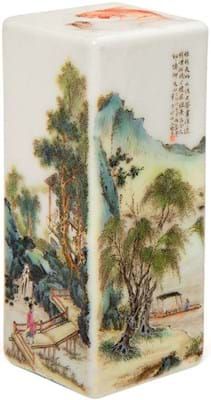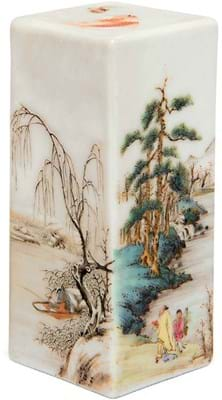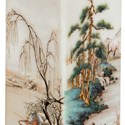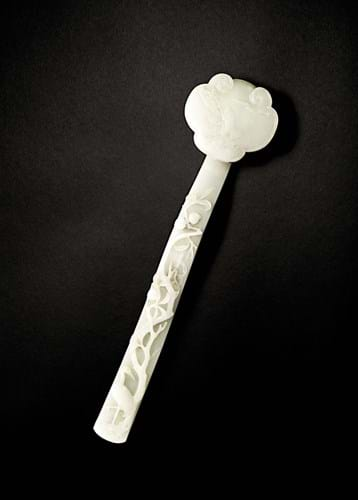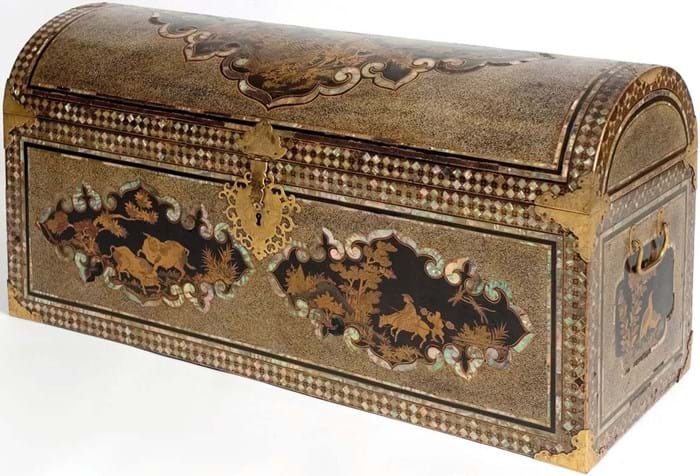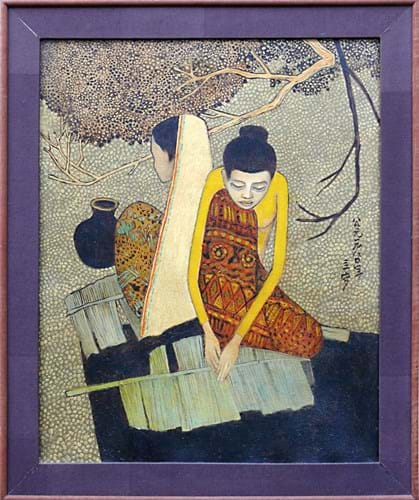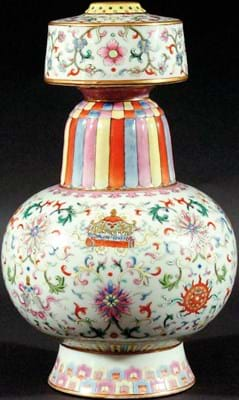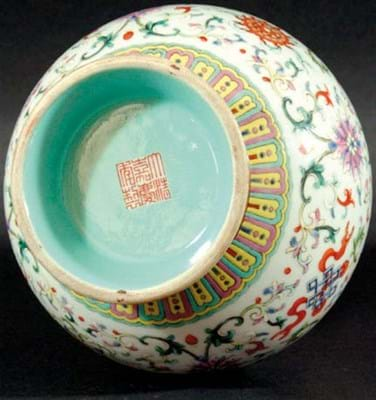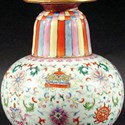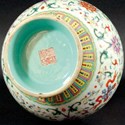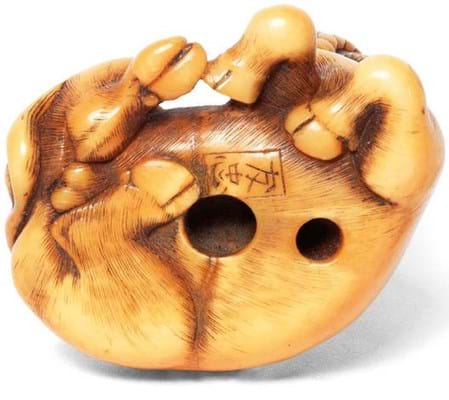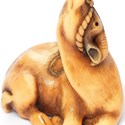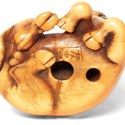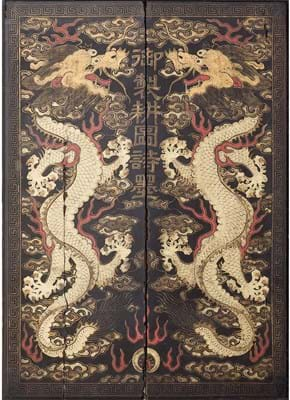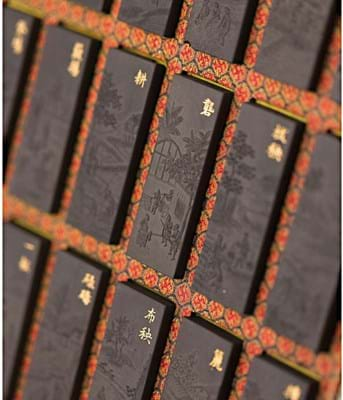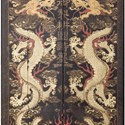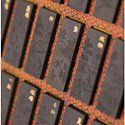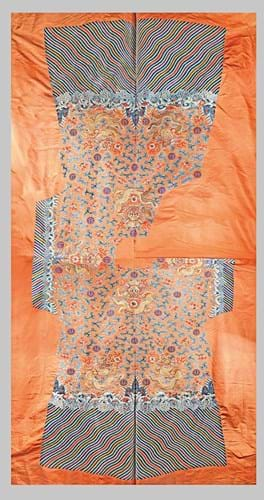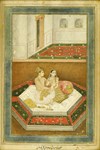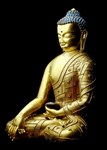Republican seals at Christie’s
The market for top-flight Republican (1912-49) porcelain – particularly pieces decorated by the ‘Eight Friends of Zhushan’ group of artists – has escalated over the past decade.
Kate Hunt, Christie’s specialist, described a pair of 3½in (9cm) famille rose ‘landscape’ seals decorated and signed by He Xuren (1882-1940) as “examples of the finest painting in the Republic period”. The owner had acquired them relatively recently in the UK.
According to the inscription, the seals were made as a gift for Zhu Peide (1888-1937), a senior commander in the Nationalist Party and the governor of Jiangxi province where the Eight Friends would meet to discuss their trade on moonlit nights. The pair sold at £180,000 (estimate £30,000-50,000) at Christie’s South Kensington on May 12 – the last Chinese works of art sale at the saleroom before its closure in July.
Qianlong vases at Christie’s

A pair of Qianlong (1736-95) mark and period famille rose ‘butterfly’ double-gourd vases that made £13m at Christie’s.
Crowning London’s Asian art auctions in the spring was this splendid pair of Qianlong (1736-95) mark and period famille rose ‘butterfly’ double-gourd vases. Estimated by Christie’s at £2m-3m, they prompted 15 minutes of bidding across 10 potential suitors before they were hammered down at £13m.
These 9in (23cm) high vases, decorated with great delicacy in falangcai enamels on an incised ‘graviata’ ground, perhaps once resided in the Yuanmingyuan or similar courtly dwelling. Collected in the 1930s in London by an English lady from a noble family, they were found by former Christie’s specialist Jeremy Morgan in the drawing room of an English country house.
The current owner had “no idea of their true value”. Only four other vases of this type are recorded (all singles), including that sold first by Christie’s in 2003 and again in 2007 for HK$13.76m.
Kangxi period rouleau vase at Lempertz
New laws relating the sale of items ‘of cultural history’ are prompting some German firms to hold their Asian auctions outside Germany. Lempertz (24/22% buyer’s premium) held its first sale of Chinese works of art on June 18 in Brussels, following a sale of Indian and Japanese objects the previous week at headquarters in Cologne.
Among the highlights was this 2ft 6in (76cm) high Kangxi period rouleau vase with famille verte decoration combining classic elements of Chinese mythology with auspicious birds and flowers. A small reserve on the neck of the vase includes an unusual motif: a laughing fisherman having his back massaged by a young boy.
This vase has changed hands many times since it was purchased in the 1950s by the discerning English collector Henry M Knight and had appeared at Lempertz before in 2003 when it was sold as part of the Bernheimer collection.
This time it sold at €80,000.
‘Hongs’ punch bowl at Tennants
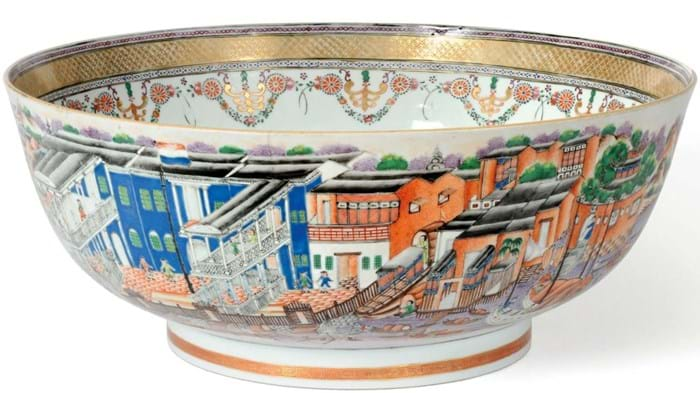
This piece of Chinese Export porcelain, a ‘Hongs’ punch bowl, sold for £70,000 at Tennants in March.
Topping the sale at Tennants (20% buyer’s premium) at Leyburn on March 24-25 was a ‘Hongs’ punch bowl – a textbook Chinese Export porcelain vessel painted in enamels to the exterior with a continuous monochrome scene of the warehouses along the Pearl River at Canton, with the national flags of Western nations identifying places of business.
Painters began adding the Stars and Stripes to these pieces in the late 1780s, which helped date this 14¼in (36cm) diameter bowl to c.1790.
Estimated at £15,000-20,000 on account of a hairline crack, it sold to a UK specialist dealer at £70,000.
A similar bowl decorated en grisaille was sold by Shrewsbury auction house Halls (20% buyer’s premium) on July 19. The 14¼in (36.5cm) diameter bowl of the same period was also damaged: smashed at some point in its two and a quarter centuries, the bowl had been given only a passable repair. Estimated at £3500-4000, it went to a London dealer at £27,000.
Yongzheng bottle vase at Halls
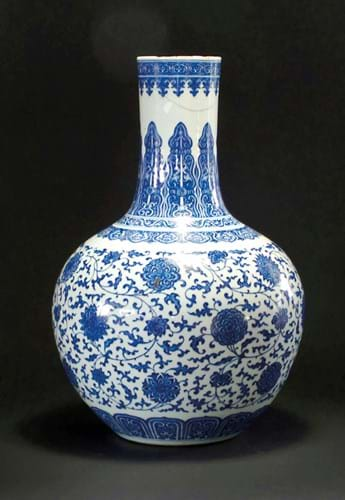
The Qing blue and white bottle vase with a Yongzheng (1723-35) mark that sold for £150,000 at Halls.
A large Qing blue and white bottle vase with a Yongzheng (1723-35) mark sold for £150,000 (plus 20% buyer’s premium) at Halls in Shrewsbury on July 17.
Standing 22in (55cm) high, with significant damage to its rim, the vase was competed for by 12 phone bidders before it was hammered down to an Asian buyer well above its £6000-10,000 estimate.
According to the vendor, it was bought privately around 40 years ago in the Southport area and had been stored away in a warehouse for several years.
The finely painted decoration of auspicious flowers, including large lotus blooms, was typical of the early 18th century period. However, Halls specialist Alexander Clement said opinion had been divided as to whether the vase was ‘mark and period’ or a later piece.
Portrait of palace guard at Nagel
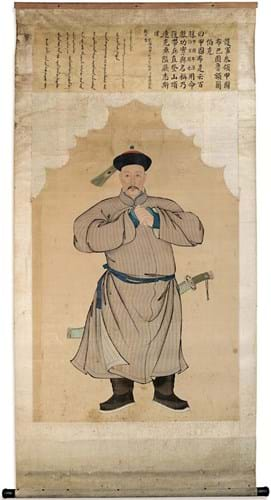
The portrait of the regimental commander of the palace guards from 1776 that sold for €400,000 (£333,335) at Nagel.
In Stuttgart, Nagel (33% buyer’s premium) closed its autumn season on December 9-10 with the sale of this portrait of the regimental commander of the palace guards.
Painted by a court artist in 1776, it is one of a hundred commissioned by the Qianlong Emperor to honour officers who had excelled themselves in the military campaign to suppress the hill people of the province of Jinchuan, now part of Sichuan.
The wall hangings were displayed in the Hall of Purple Splendour in the Imperial Palace until 1900 when, during the Boxer Rebellion, the hall was plundered and the hangings dispersed. Around this time a German collector bought this particular painting, which had remained in the family ever since.
Nagel’s estimate of €20,000-30,000 proved modest. The hammer price of €400,000 (£333,335) was the highest of the sale, with the portrait falling to a Hong Kong collector.
Sikh warrior steel rings at Sotheby’s

The chakkar quoits – Sikh warrior steel rings – dating from the 18th and 19th centuries that sold for £26,000 at Sotheby’s.
These steel rings are chakkar quoits – razor-sharp weapons popular in the 18th century with Sikh warriors. They were worn on the wrist or carried in a turban.
The three quoits in Sotheby’s eclectic sale in Bond Street on January 19 offering lots Of Royal and Noble Descent came from Coulston House, East Lothian, home of James Andrew Broun-Ramsay, Marquess of Dalhousie (1812-60).
Dalhousie was Governor General of India and garnered an impressive collection of Indian works of art. It is thought the quoits were either presented to him following the annexation of the Punjab, when the second Sikh war concluded in 1849, or were a war trophy.
The larger 9in (23cm) example was deemed 18th century and used as a weapon while the smaller, lighter ones probably dated to the 19th century when quoits became largely ceremonial objects.
Estimated at £1500-2500, they attracted considerable interest from Sikh bidders, proud of their warrior heritage, pushing the price to £26,000 (plus 25% premium).
Jade ruyi sceptre at Sotheby’s Paris
Sotheby’s sale in Paris on June 22 included this 15½in (39cm) long celadon jade ruyi sceptre that had been in a French private collection since the early 20th century.
The quality of the stone and the carving were strong elements of its appeal. However, even more of an attraction was the engraved poem by the Qianlong emperor dated to 1773. The inscription suggests this piece was a gift to his mother, the dowager empress, for her 82nd birthday.
Eclipsing its €200,000-300,000 guide, the price for this imperial gift was €1.25m (£1.1m).
Japanese coffer at Charterhouse
This Japanese lacquer coffer from the Momoyama or early Edo period (1590-1625) was sold by Charterhouse (20% buyer’s premium) of Sherborne on February 17 for £55,000.
Estimated at £5000-10,000, it was offered for sale on behalf of a London-based client who had kept it in storage in Reading. It was bought by a London dealer.
From the late 16th century, when Europeans began to arrive in Japan for trade and Christian missions, Japanese craftsmen developed a style of lacquer especially for export. The namban or ‘southern barbarian’ style combined European forms and a hybrid form of gold hiramaki-e and abalone shell decoration and elaborate gilt copper mounts considered appropriate for Westerners.
That these differed from indigenous furniture is apparent in the terminology employed by the Japanese to describe them. Famously, domed coffers such as this were known locally as kanabokogata or ‘boxes in fish-sausage shape’.
This example, measuring 3ft 1in wide x 18in high (95 x 47cm), was in good condition, showing only minor damage and losses to the mother-of-pearl.
Xuande bowl at Sotheby’s Hong Kong
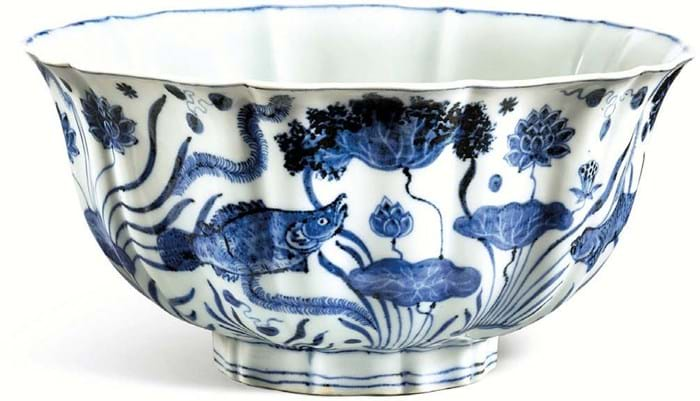
The Xuande mark and period ‘fish pond’ bowl that made HK$229m (£22.9m) at Sotheby’s Hong Kong in April.
A Xuande mark and period ‘fish pond’ bowl, trumpeted by Sotheby’s as among the greatest examples of early Ming blue and white porcelain in private hands, sold in Hong Kong for HK$229m (£22.9m) on April 4. The 9in (23cm) lobed bowl, expected to fetch ‘in excess of HK$100m’, sold to an Asian private collector.
No comparable piece from the reign of the art-loving Xuande emperor (1425-35) had ever been offered at auction before. The only similar examples are two smaller bowls preserved in the National Palace Museum, Taipei. This example, in perfect condition, has been extensively published in Japan since its first public exhibition at the Tokyo National Museum in 1963.
The price is the second highest ever for Ming porcelain, after the Chenghua period ‘chicken cup’ which sold for HK$250m (£21.5m) at Sotheby’s in 2014.
Cheong Soo Pieng paintings at Geble
Virtually all the paintings by the celebrated Malayan artist Cheong Soo Pieng (1917-83) sold at auction in recent decades have been offered in either Hong Kong or Singapore.
So it was a surprise when Geble (19% buyer’s premium) in Radolfzell, on the shores of Lake Constance, sold three of his works on April 29 – offered by the descendants of a German collector who bought them in Singapore in 1983.
Seventeen phone bidders competed with others in the room, producing a trio of substantial results – topped by Two Seated Malay Women (2ft 6in x 2ft; 77 x 62cm), that quadrupled hopes when it sold to a buyer from Kuala Lumpur at €80,000 (£68,375).
Fujita Museum sale at Christie’s New York

A ritual wine vessel or Fangzun from the late Shang dynasty (13th-11th century BC) that made $33m (£27m) at the Fujita Museum sale at Christie’s New York.
A select sale of just 31 lots of Chinese art assembled by a Japanese family raised a record-breaking $262.8m (£215.5m) at Christie’s New York on March 15. It made more in a single evening than any previous New York Asian sale series.
The selection of archaic bronzes, classical paintings, Buddhist sculpture, celadon ceramics and scholars’ objects from the Fujita Museum had been assembled by Denzaburo Fujita (1841-1912) and his two sons Heitaro and Tokujiro. The items had been acquired prior to 1940, largely through the leading dealers Yamanaka and Co.
One of the Fujitas’ six archaic bronzes, this 20in (52cm) high ritual wine vessel or Fangzun from the late Shang dynasty (13th-11th century BC) set a new auction high for an archaic bronze when it sold for a hammer price of $33m (£27m).
Qing altar vases at Lawrences
This 10¼in (26cm) high altar vase or benbaping belongs to a group of ritual wares commissioned by the Qing court for ceremonial use in palaces and temples. Made to contain sacred plants and herbs, the inspiration for the distinctive form comes from Tibetan jewel-encrusted silver vessels.
The decoration in famille rose enamels includes the Bajixiang, the Eight Buddhist Emblems, divided by lotus heads and scrolls. Vessels of this type were used throughout the Qianlong period but this example carries an iron-red six-character seal for his successor, the fifth Qing emperor Jaiqing (1796-1820).
It came for sale at Lawrences (22% buyer’s premium) of Crewkerne on January 19, consigned by the descendant of a solicitor who worked in Shanghai in the early 20th century. It had been in the UK since the 1930s and had spent 30 years on the Wiltshire vendor’s mantelpiece.
The auctioneers catalogued cautiously as Republican period and gave it an estimate of £1200-1500. However, it sold to a prominent Hong Kong dealership at £252,000.
Netsuke collection at Bonhams
The centrepiece of Bonhams’ Japanese offering on May 11 was the second part of the extraordinary collection of netsuke formed by US concert pianist Julius Katchen (1926-69) and his wife Arlette.
The couple made their first purchase in Kyoto while on a concert tour of Japan in 1953, later immersing themselves in the subject with the encouragement of London dealer Geoffrey Moss.
Many important purchases were made across the series of sales of the MT Hindson collection at Sotheby’s in the late 1960s. They included an ivory model of a recumbent ox by the 18th century Kyoto master Tomotada. The compact study, admired in a number of important 20th century collections including that of Isobel Sharpe, is believed to be unique. It sold for £120,000 (estimate £25,000-30,000).
It was at the final Hindson sale in 1969 – sadly two months after Julius Katchen had died – that his widow had purchased, in his memory, a celebrated netsuke of a shaggy dog and pup by the enigmatic late 18th and early 19th century carver Gechu.
This carving sold to a solitary bid of £180,000 in the first Katchen sale in November.
Imperial inksticks at Lyon & Turnbull
Lyon & Turnbull’s (25/20/12% buyer’s premium) sale at the Hellenic Centre in Marylebone on May 9 included one of the most-contested lots of the series.
Estimated at £2000-3000 but sold at £155,000 was a set of 48 imperial inksticks contained in two fine gilt-lacquered ‘dragon’ boxes.
Together they illustrate stages of cotton cultivation and manufacturing in imperial China, each 3 x 1in (7 x 2.5cm) stick delicately carved on the one side, and inscribed with a poem by Qianlong on the reverse.
One of the inksticks is inscribed with a ‘table of contents’ while another with an introductory essay is signed ‘carved by Wang Weigao, supervisor of ink-making in the Imperial Library’.
The set, from a private Scottish collection, had been acquired in Edinburgh in the 1980s.
Official court robes at Woolley & Wallis
For the most important ceremonies and rituals, high-ranking Chinese officials along with the royal family would don the chao fu or full court dress.
At the Qing court a whole range of garments and paraphernalia were associated with the chao fu – a hat, collar, necklace, girdle and boots – but the most important were the chao pao and jifu, the court robes. Their use was restricted to high-ranking officials and persons.
Robes with an apricot-yellow ground were reserved for the crown prince, his consorts and the crown princess. The uncut example offered at Woolley & Wallis in Salisbury on May 16, embroidered with five-clawed dragons, bats holding peaches above waves and Buddhist emblems, was from the late Qing period. Estimated at £3000-5000, it sold at £17,000.
Ovoid jar at Mallams
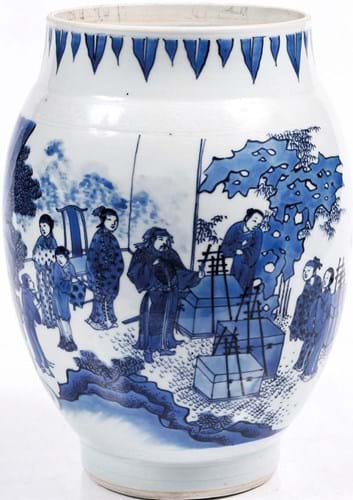
The ovoid jar with decoration taken from ‘Romance of the Three Kingdoms’ c.1630-50 that sold for £36,000 at Mallams.
The painterly blue and white Transitional porcelains made in the years between the Ming and Qing dynasties, when the loss of court patronage allowed for greater artistic freedom, were among the first wares to gain popularity with the new generation of Chinese collectors.
Many carry scenes inspired by traditional folklore and woodcut illustrations that were available for artists to copy by this period.
A typical 11in (27cm) ovoid jar with decoration taken from Romance of the Three Kingdoms c.1630-50 sold to an internet bidder for £36,000 at Mallams in Cheltenham on April 26. Inherited by the vendor from his father, it had been spotted by auctioneer Robin Fisher when invited to value an oak dresser.
Guangxu period silk painting at Tessier & Sarrou

The 4ft 8in x 9ft 10in (1.36 x 3m) Guangxu period silk painting that made €650,000 (£575,220) at Tessier & Sarrou.
A huge painting on silk from the Guangxu period (1875-1908) generated great interest in a June 26 sale held by Tessier & Sarrou (25% buyer’s premium) at the Drouot in Paris.
The painting is part of a group of 67 works depicting military victories commissioned for the imperial court.
This 4ft 8in x 9ft 10in (1.36 x 3m) composition depicts incidents from a battle in which a Qing army was victorious over the Nian rebels, an anti-Manchu revolutionary movement in northern China. The names of high-profile participants are indicated in a rectangular panel.
The €30,000-50,000 estimate proved wide of the mark when the hammer finally fell at €650,000 (£575,220).


